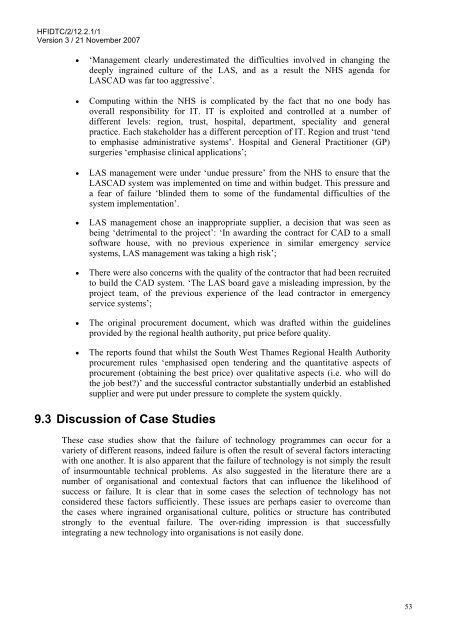The Impact of Technology Insertion on Organisations
The Impact of Technology Insertion on Organisations
The Impact of Technology Insertion on Organisations
You also want an ePaper? Increase the reach of your titles
YUMPU automatically turns print PDFs into web optimized ePapers that Google loves.
HFIDTC/2/12.2.1/1<br />
Versi<strong>on</strong> 3 / 21 November 2007<br />
• ‘Management clearly underestimated the difficulties involved in changing the<br />
deeply ingrained culture <str<strong>on</strong>g>of</str<strong>on</strong>g> the LAS, and as a result the NHS agenda for<br />
LASCAD was far too aggressive’.<br />
• Computing within the NHS is complicated by the fact that no <strong>on</strong>e body has<br />
overall resp<strong>on</strong>sibility for IT. IT is exploited and c<strong>on</strong>trolled at a number <str<strong>on</strong>g>of</str<strong>on</strong>g><br />
different levels: regi<strong>on</strong>, trust, hospital, department, speciality and general<br />
practice. Each stakeholder has a different percepti<strong>on</strong> <str<strong>on</strong>g>of</str<strong>on</strong>g> IT. Regi<strong>on</strong> and trust ‘tend<br />
to emphasise administrative systems’. Hospital and General Practiti<strong>on</strong>er (GP)<br />
surgeries ‘emphasise clinical applicati<strong>on</strong>s’;<br />
• LAS management were under ‘undue pressure’ from the NHS to ensure that the<br />
LASCAD system was implemented <strong>on</strong> time and within budget. This pressure and<br />
a fear <str<strong>on</strong>g>of</str<strong>on</strong>g> failure ‘blinded them to some <str<strong>on</strong>g>of</str<strong>on</strong>g> the fundamental difficulties <str<strong>on</strong>g>of</str<strong>on</strong>g> the<br />
system implementati<strong>on</strong>’.<br />
• LAS management chose an inappropriate supplier, a decisi<strong>on</strong> that was seen as<br />
being ‘detrimental to the project’: ‘In awarding the c<strong>on</strong>tract for CAD to a small<br />
s<str<strong>on</strong>g>of</str<strong>on</strong>g>tware house, with no previous experience in similar emergency service<br />
systems, LAS management was taking a high risk’;<br />
• <str<strong>on</strong>g>The</str<strong>on</strong>g>re were also c<strong>on</strong>cerns with the quality <str<strong>on</strong>g>of</str<strong>on</strong>g> the c<strong>on</strong>tractor that had been recruited<br />
to build the CAD system. ‘<str<strong>on</strong>g>The</str<strong>on</strong>g> LAS board gave a misleading impressi<strong>on</strong>, by the<br />
project team, <str<strong>on</strong>g>of</str<strong>on</strong>g> the previous experience <str<strong>on</strong>g>of</str<strong>on</strong>g> the lead c<strong>on</strong>tractor in emergency<br />
service systems’;<br />
• <str<strong>on</strong>g>The</str<strong>on</strong>g> original procurement document, which was drafted within the guidelines<br />
provided by the regi<strong>on</strong>al health authority, put price before quality.<br />
• <str<strong>on</strong>g>The</str<strong>on</strong>g> reports found that whilst the South West Thames Regi<strong>on</strong>al Health Authority<br />
procurement rules ‘emphasised open tendering and the quantitative aspects <str<strong>on</strong>g>of</str<strong>on</strong>g><br />
procurement (obtaining the best price) over qualitative aspects (i.e. who will do<br />
the job best?)’ and the successful c<strong>on</strong>tractor substantially underbid an established<br />
supplier and were put under pressure to complete the system quickly.<br />
9.3 Discussi<strong>on</strong> <str<strong>on</strong>g>of</str<strong>on</strong>g> Case Studies<br />
<str<strong>on</strong>g>The</str<strong>on</strong>g>se case studies show that the failure <str<strong>on</strong>g>of</str<strong>on</strong>g> technology programmes can occur for a<br />
variety <str<strong>on</strong>g>of</str<strong>on</strong>g> different reas<strong>on</strong>s, indeed failure is <str<strong>on</strong>g>of</str<strong>on</strong>g>ten the result <str<strong>on</strong>g>of</str<strong>on</strong>g> several factors interacting<br />
with <strong>on</strong>e another. It is also apparent that the failure <str<strong>on</strong>g>of</str<strong>on</strong>g> technology is not simply the result<br />
<str<strong>on</strong>g>of</str<strong>on</strong>g> insurmountable technical problems. As also suggested in the literature there are a<br />
number <str<strong>on</strong>g>of</str<strong>on</strong>g> organisati<strong>on</strong>al and c<strong>on</strong>textual factors that can influence the likelihood <str<strong>on</strong>g>of</str<strong>on</strong>g><br />
success or failure. It is clear that in some cases the selecti<strong>on</strong> <str<strong>on</strong>g>of</str<strong>on</strong>g> technology has not<br />
c<strong>on</strong>sidered these factors sufficiently. <str<strong>on</strong>g>The</str<strong>on</strong>g>se issues are perhaps easier to overcome than<br />
the cases where ingrained organisati<strong>on</strong>al culture, politics or structure has c<strong>on</strong>tributed<br />
str<strong>on</strong>gly to the eventual failure. <str<strong>on</strong>g>The</str<strong>on</strong>g> over-riding impressi<strong>on</strong> is that successfully<br />
integrating a new technology into organisati<strong>on</strong>s is not easily d<strong>on</strong>e.<br />
53

















